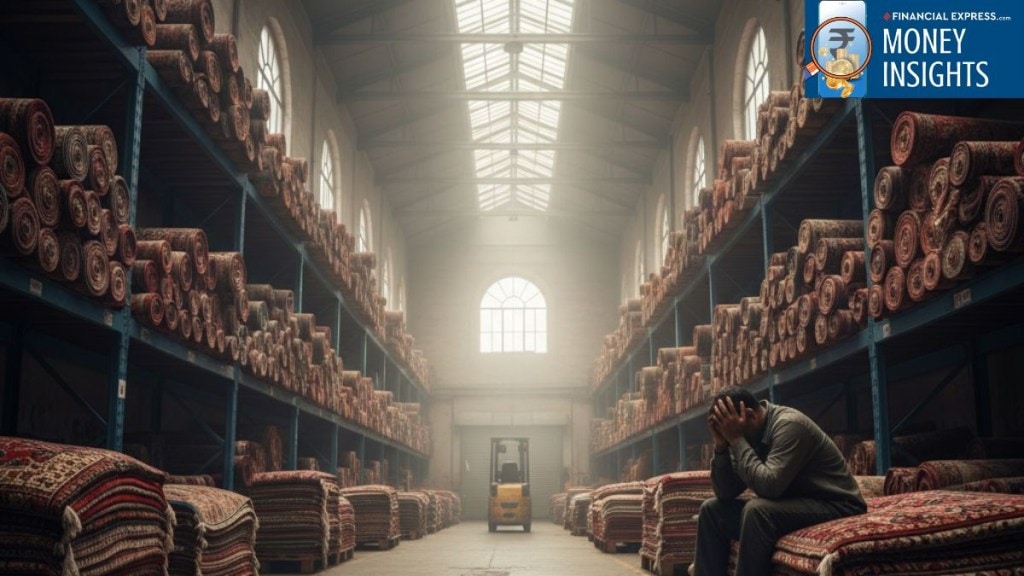I live in Bhadohi, the carpet city of India. I still remember the first time I walked into a factory. The sound struck me before the sight did – wood creaking, threads pulling, hands moving in rhythm. Dozens of men bent over hand-knotted rugs, their conversations drowned out by the thump of the looms. It’s a rhythm my husband and his workers know by heart.
But lately, the rhythm feels broken. Orders that once came easily from the US, our biggest market, now arrive slower, trapped in tariff talk. I’ve seen workers leave by afternoon because electricity costs were no longer justifiable without new orders. A factory owner told me he runs just two shifts a week, “not for profit, but so my men don’t go home empty-handed.”
One speech in Washington, one tariff line, and suddenly dinner-table conversations here turn into questions of survival : Will the factory keep everyone this month?
That’s when it hit me: when Washington sneezes, our looms catch a cold.
The money lesson I didn’t expect
Watching this unfold has been my crash course in financial planning. The day my husband came home with a cancelled order, I realised how fragile income can be. When exports stumble, so do our small joys.
For me, the lesson was simple: savings can’t be an afterthought. They are the only safety net when global politics plays dice with your livelihood. Just as my mother once tucked away gold coins “for a rainy day,” I now treat our emergency fund as non-negotiable. It isn’t fancy, just a liquid cushion to keep the household running when winds turn rough.
Yes, the data paints a colourful picture on the surface. India’s total exports in July 2025 stood at US$ 68.27 billion, a 4.52% rise from last year. Carpets too rose 8.05% in July to US$ 133 million. But talk to the weavers and you’ll hear the unease. Numbers may show growth, yet one tariff decision can wipe away months of work. Growth doesn’t always mean security.
That’s why I’ve started looking at our family finances like a micro-economy. Build reserves when times are good. Diversify where possible. And always assume a slowdown could be around the corner.
Why resilience matters
The world sees export charts. We see the faces behind them. Men weaving late into the night, women balancing shrinking budgets, children whose futures rest on how steady orders stay.
Here in Bhadohi, resilience is not a buzzword, it’s survival. Our factories survived demonetisation, GST, and even COVID lockdowns. Each time the rhythm broke, we stitched it back together.
And that lesson isn’t just for exporters. Shocks arrive in every household: a sudden layoff, a medical bill, an EMI that jumps overnight. You don’t need to run a business to know how fragile “normal” can be.
So, here are the financial lessons our family learned the hard way:
- Build an emergency fund. Start with three to six months of expenses. It’s the difference between panic and breathing room.
- Diversify your income. Don’t let one source of income decide your future. A side hustle, rental income, even a modest SIP matters.
- Prepare for stress months. My father always said, “Every day is not a Sunday.” Planning for rainy months is sobering, but powerful.
- Don’t confuse growth with stability. The 8% rise in carpet exports didn’t mean every weaver slept peacefully. Numbers can be up, yet uncertainty remains.
The bigger picture
Policy shocks are inevitable. The UK-India FTA may open new doors, but until then, small exporters like us are learning to live leaner, stretch every rupee, and keep workers employed even in thin times.
That’s resilience. And for families, it looks the same. You can’t control the noise outside, but you can build buffers inside your home.
Trade wars may be fought oceans away, but their aftermath is lived in towns like mine. And the biggest truth I’ve learned is this: life is not about becoming rich, it’s about becoming steady.
Because when Washington sneezes, our factories do catch a cold. But with an emergency fund and a plan, at least the house stays warm.
Note:
The purpose of this article is to share insights, data points, and thought-provoking perspectives on investing. It is not investment advice. If you wish to act on any investment idea, you are strongly advised to consult a qualified advisor. This article is strictly for educational purposes. The views expressed are personal and do not reflect those of my current or past employers.
Sneha Virmani is a content strategist and writer with over a decade of experience. She is an alumna of Lady Shri Ram College, Delhi University (Economics & Psychology). Sneha specialises in storytelling-led content strategies and consumer education campaigns. Her work brings context and clarity, with a no-jargon approach designed to engage everyday readers.
Disclosure: The writer and his dependents do not hold the stocks discussed in this article. The website managers, its employee(s) and contributors/writers/authors of articles have or may have an outstanding buy or sell position or holding in the securities, options on securities or other related investments of issuers and/or companies discussed therein. The content of the articles and the interpretation of data are solely the personal views of the contributors/ writers/authors. Investors must make their own investment decisions based on their specific objectives, resources and only after consulting such independent advisors as may be necessary.

